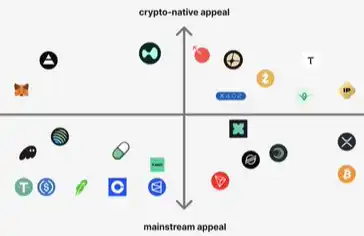From Spotlight to the Sidelines: The Bubble Burst of 8 Star VC-Backed Projects
Is it because the model is unsustainable, the ecosystem has yet to launch, the competitors are too strong, or is there simply insufficient market demand?
Is it that the model is unsustainable? The ecosystem has yet to launch? Or are the competitors too strong and market demand insufficient?
Written by: Biteye core contributor Viee
Edited by: Biteye core contributor Denise
In the crypto industry, every bull market gives birth to countless "spotlight projects": highly sought after by top VCs, listed on major exchanges, and attracting a flood of retail investors. But time is the sharpest touchstone—some projects have dropped 90% or even over 99% from their peaks, and their discussion volume has declined year by year.
This article reviews 8 projects that were invested in by star VCs and once held high expectations during the bull market. From ICP to DYM, we will focus on analyzing their funding backgrounds, market cap trajectories, and the deep reasons behind their crashes—Is it that the model is unsustainable? The ecosystem has yet to launch? Or are the competitors too strong and market demand insufficient?
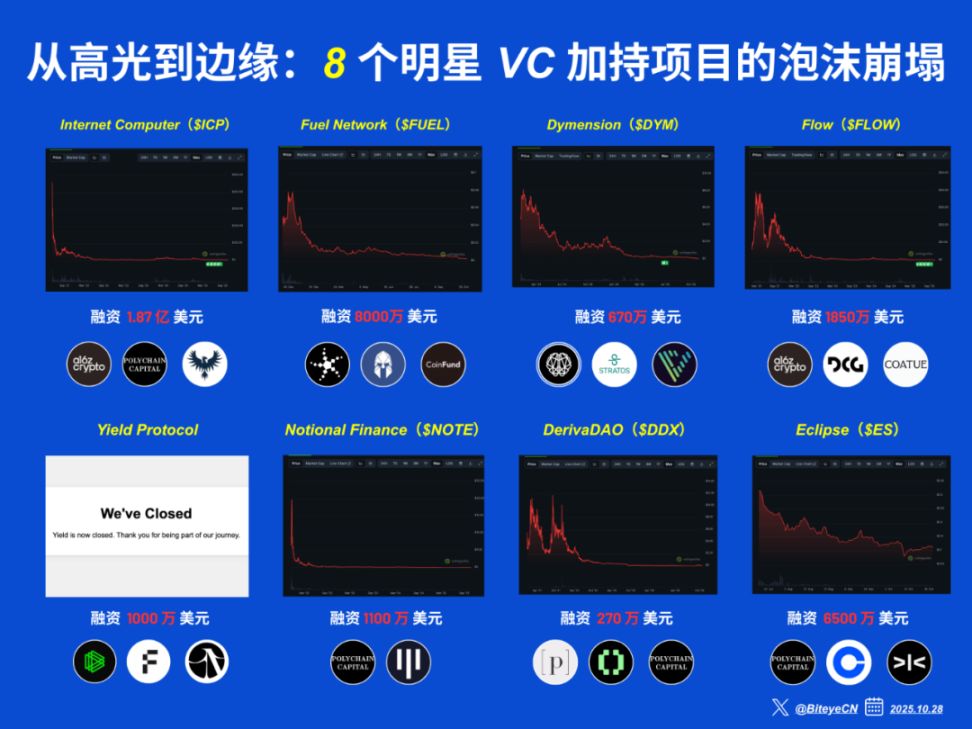
Internet Computer ($ICP)
Once ranked in the top five, now down 99.5%
Internet Computer (ICP), launched by the Dfinity Foundation, positions itself as a decentralized "internet computer," aiming to enable smart contracts to natively run various internet services. The project began R&D in 2018 and went live at the bull market peak in May 2021, immediately entering the top five in crypto market cap and attracting significant market attention.
ICP attracted top Silicon Valley VCs, including a16z, Polychain Capital, Multicoin, CoinFund, and others, with total funding reaching $187 million. ICP's initial price was several hundred dollars, peaking at nearly $700, but quickly fell below $20 within two months after launch. As of 2025, ICP has long hovered around $3, down over 99% from its peak.
The main reasons for the project's failure include valuation bubbles, rushed launch, insufficient initial liquidity, and external doubts about project governance and centralization. In addition, the ecosystem developed slowly and failed to deliver on its early promise to "reshape the internet."
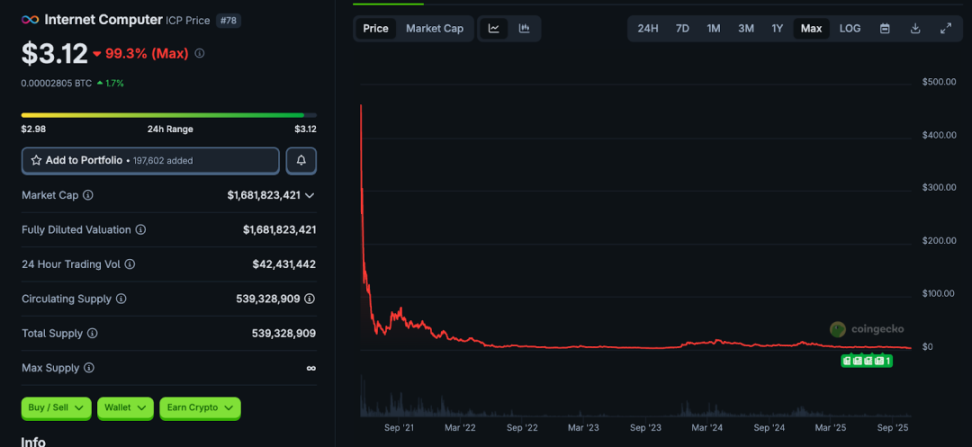
Fuel Network ($FUEL)
Ambition for a modular execution layer, reality yet to be realized
Fuel Network is a layer 2 solution for Ethereum scalability, with the core goal of separating the execution layer from consensus and data availability to improve throughput and reduce costs.
The project has backing from institutions including Blockchain Capital, The Spartan Group, CoinFund, and others, with strategic funding reportedly reaching at least $80 million.
However, in terms of token performance and ecosystem adoption, Fuel Network has not met expectations. The current price of FUEL is about $0.003, with a market cap of only tens of millions of dollars, down over 94% from its peak. With Ethereum scaling, various L2s, and modular chain solutions emerging one after another, it remains questionable whether Fuel's differentiation advantage can be sustained in the long term.
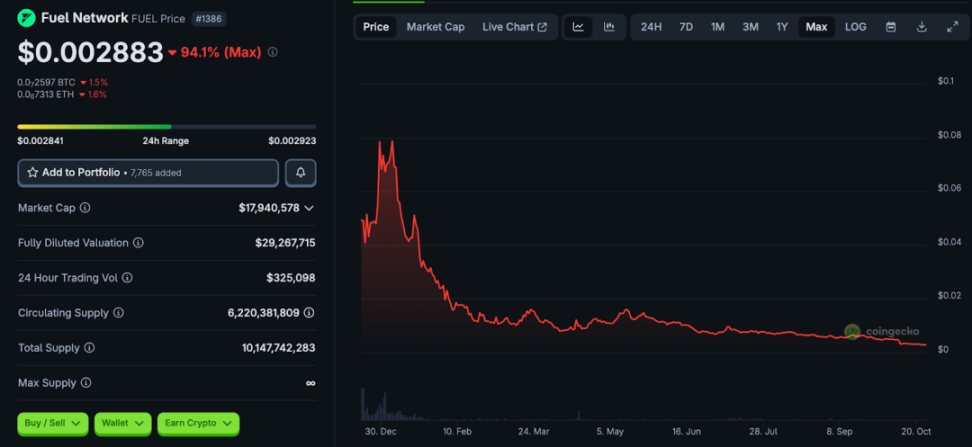
Dymension ($DYM)
A new attempt at RollApps architecture, price has dropped over 97%
Dymension is a project focused on "modular blockchain" infrastructure, featuring an L1 network where developers can quickly deploy application-specific chains ("RollApps"). Its design separates consensus and settlement layers, and builds RollApps within the ecosystem to optimize scalability and customization.
The project launched in 2022, with the DYM token going live in early 2024. Despite its clear technical positioning and backing from Big Brain Holdings, Stratos, Cogitent Ventures, and other investors, DYM's market performance has seen its price drop over 97% from its peak. Data shows its historical high was close to $8.50, while the current price is around $0.10. Although the project is still running, ecosystem development is slow, and community and user engagement have not met expectations.
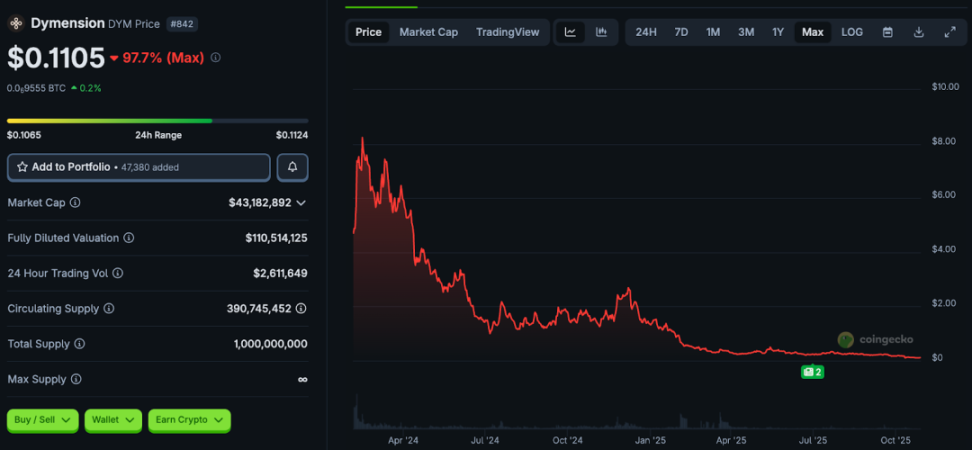
Flow ($FLOW)
Once a star NFT chain, now lost attention
Flow is a high-performance public chain launched by Dapper Labs, focusing on NFTs and gaming applications. In October 2020, the FLOW token was launched via a public sale on CoinList, and the ecosystem was once active thanks to the NFT boom in 2021.
The project had strong funding backing. From 2018 to 2021, Dapper Labs received multiple rounds of investment from a16z, DCG, Coatue, and others, with total funding exceeding $185 million. FLOW's price reached an all-time high of about $42 in April 2021, then continued to fall with the market. As of 2025, the price has dropped to $0.28, down over 96% from its peak, and its market cap has shrunk significantly.
Flow's decline is closely related to the cooling of the NFT market. The ecosystem relied on a single blockbuster application, lacked sustained growth momentum, and in the long run, lacked user retention and real demand support.
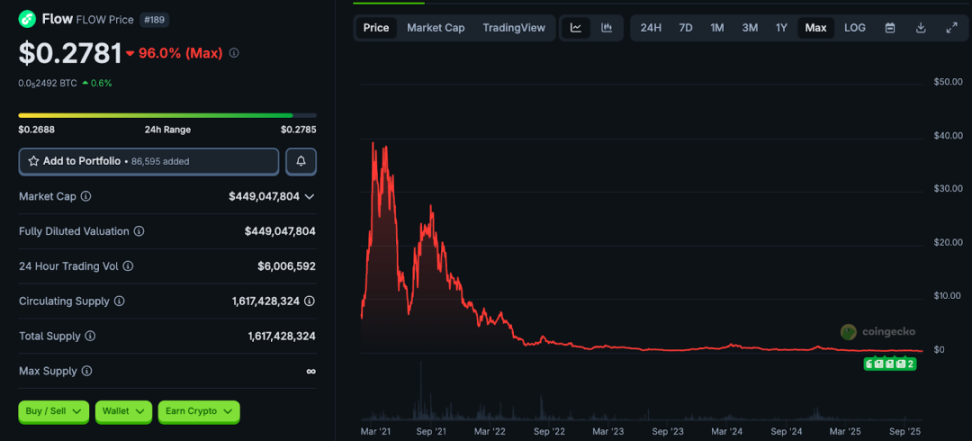
Yield Protocol
Paradigm-backed fixed-rate protocol, shut down in 2023
Yield Protocol was an Ethereum-based lending protocol focused on fixed-term, fixed-rate lending, issuing fyToken to create bond-like lending products. The project launched in 2019 and was once seen as a pioneer in the DeFi fixed income sector.
In June 2021, Yield completed a $10 million Series A round led by Paradigm, with participation from Framework Ventures, CMS Holdings, and other well-known institutions.
However, in October 2023, Yield Protocol officially announced the shutdown of the protocol, and the website was taken offline.
The core reason for the project's failure was insufficient demand for fixed-rate lending, making it difficult to maintain an effective market. At the same time, with the overall downturn in the DeFi market and increasing regulatory pressure, Yield could not form a sustainable product model and ultimately chose to cease operations, becoming one of the few star VC-backed projects to officially shut down in recent years.
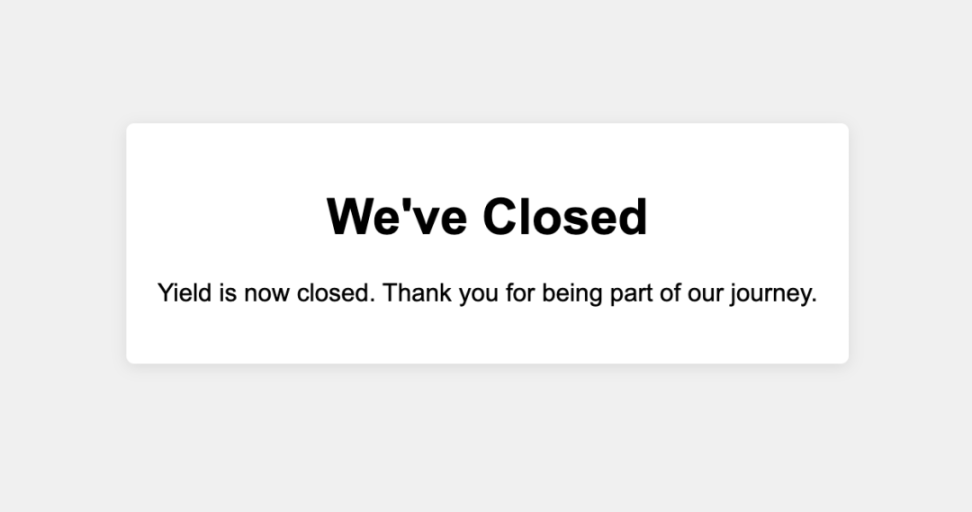
Notional Finance ($NOTE)
A fixed-rate lending protocol, gradually marginalized
Notional Finance is a fixed-rate lending protocol deployed on Ethereum, allowing users to lend and borrow USDC, DAI, ETH, WBTC, and other assets at fixed terms, aiming to fill the gap for "stable yield" products in the DeFi market.
In May 2021, Notional completed a Series A round led by Coinbase Ventures, with participation from Polychain Capital, Pantera Capital, and other top institutions, raising over $11 million in total.
As of 2025, the NOTE token's market cap is only about $1.66 million, down over 99% from its peak, with daily trading volume less than $1,000. Community activity and protocol update frequency are both low.
The core issues faced by Notional are similar to those of Yield Protocol: fixed-rate products have always had limited user acceptance in the DeFi market and lack sufficient liquidity support. At the same time, its design differs significantly from mainstream lending protocols, resulting in low user migration willingness and eventual marginalization by the market.
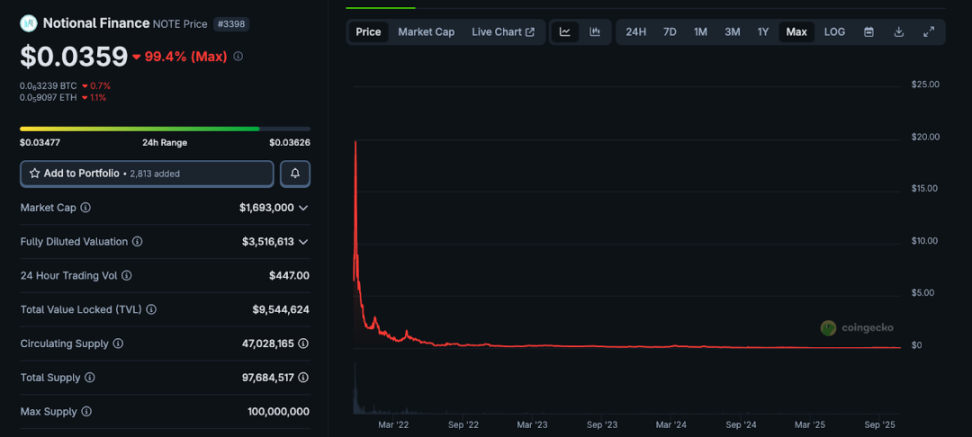
DerivaDAO ($DDX)
From star derivatives DEX to marginal delisting
DerivaDAO is a decentralized perpetual contract exchange project, first proposed in 2020, positioned as a derivatives platform combining the operational experience of CEXs with the security of DEXs. The project emphasized community governance, attempting to replace centralized operations with a DAO model.
In July 2020, DerivaDAO received investment from top VCs such as Polychain, Coinbase Ventures, and Dragonfly, with total funding of $2.7 million. Although not large in scale, the lineup was considered star-level. After launching in 2021, the price once reached about $15 but quickly declined. As of 2025, DDX has long hovered in the $0.01~$0.04 range, down over 99% from its peak, with the project's market cap nearly zero.
Due to the product's delayed launch and lack of competitive features, combined with an aggressive early mining incentive mechanism that led to rapid token release without actual trading demand, and facing strong competitors like DYDX, DerivaDAO found it difficult to break through.
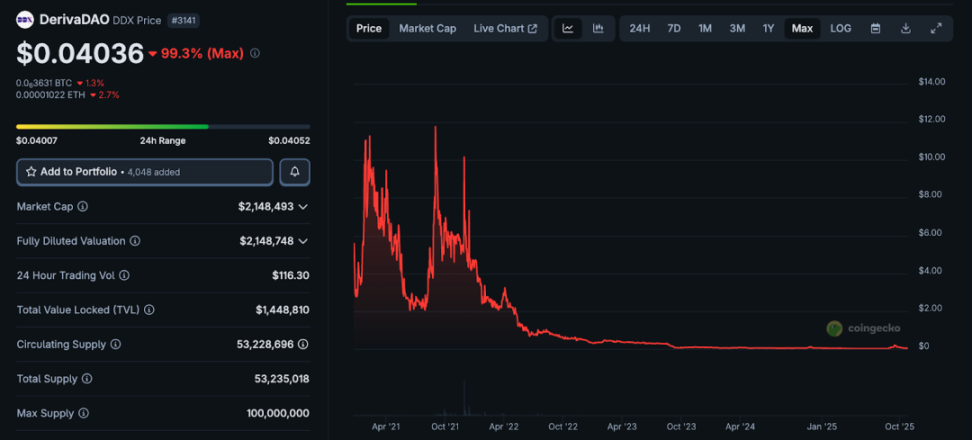
Eclipse ($ES)
Next-generation L2 infrastructure experiment, retraced over 64%
Eclipse is a Layer 2 solution combining Ethereum's security with Solana's high performance. The project launched its mainnet in 2024, and the ES token was launched in July 2025.
The project received investment from well-known VCs including Placeholder, Hack VC, Polychain Capital, and others, with funding of about $65 million.
However, from a market perspective, the ES token valuation has seen a significant retracement. According to CoinGecko data, ES is still trading but has dropped about 64% from its peak. The Eclipse ecosystem is still in its early stages, with fierce competition among roll-up or modular chain solutions, and many projects vying for the L2 track. The project's path to market adoption has yet to fully emerge.
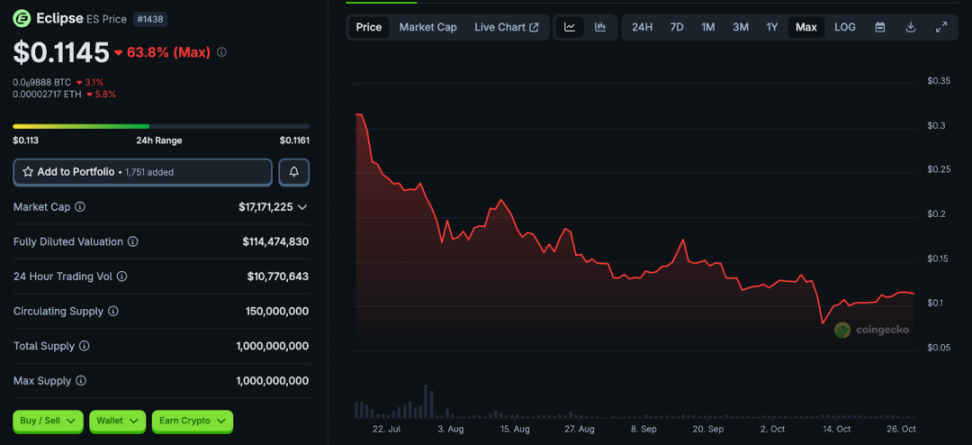
Conclusion
This article is not meant to criticize or stir up emotions, but rather to calmly review the "crash samples" from the last boom before the next cycle arrives.
They once had the brightest capital, narratives, and communities—yet still could not escape the trajectory of decoupling, collapse, stall, and marginalization. In a market highly intertwined with finance and technology, relying solely on funding, token price, and hype is far from enough. Is the business model viable? Can users be retained? Is the product being continuously developed? These are the real core variables that determine a project's fate.
These stories also remind us not to focus only on VC endorsements or short-term surges, but to learn to identify whether the long-term structure is sound.
When the tide goes out, what remains is the true value.
Disclaimer: The content of this article solely reflects the author's opinion and does not represent the platform in any capacity. This article is not intended to serve as a reference for making investment decisions.
You may also like
River will launch its public offering on October 29.
This public offering uses a 48-hour Dutch auction with uniform settlement at the lowest price. After the auction ends, immediate claiming and refunds will be available.

The Fed's Five-Way Power Struggle: Crypto Market Faces a Critical Turning Point


What drives the price surge of cryptocurrencies with no revenue?
